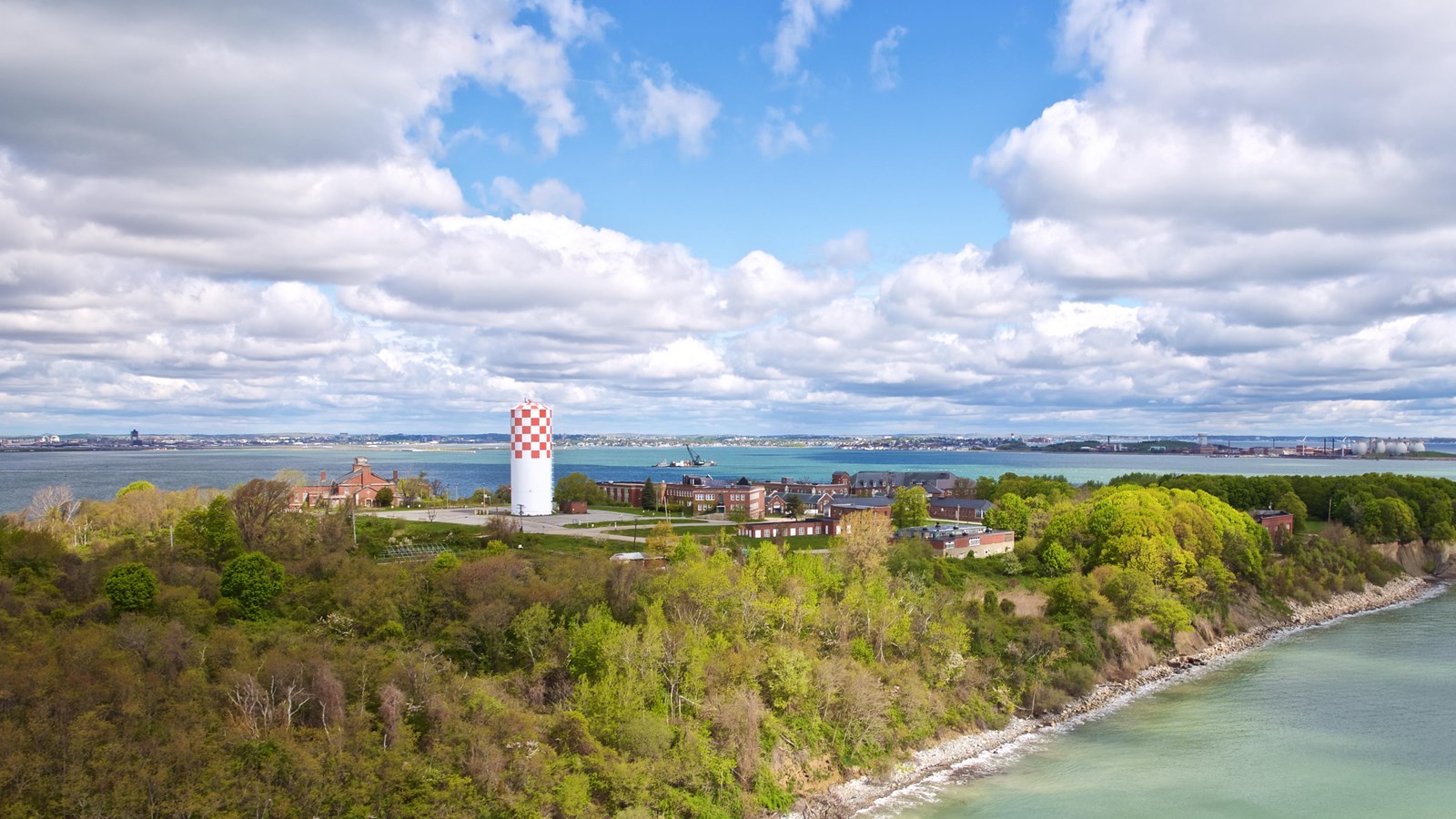Last updated: October 27, 2023
Place
Long Island, Boston

Boston Harbor Now/Liz Cook
Just five miles out from Boston sits the biggest of the Boston Harbor Islands, aptly named Long Island. At 225 acres, the island is composed of three drumlins and a freshwater marsh on the west side of the island. Today, Long Island is owned by the City of Boston and is not accessible by public ferry or private boat.1
Prior to European colonization, local Indigenous communities accessed Long Island seasonally. When European encroachment of the region led to Metacom's Rebellion (also known as King Philip's War) from 1675-1676, colonists used Long Island as an incarceration site for "Christianized" Indigenous peoples whom colonists feared might join the rebellion. Many of those incarcerated here had been moved from Deer Island, an internment camp that had become overcrowded. Hundreds perished due to extreme conditions and starvation. A burial site remains on the island today.2
During the Siege of Boston in 1775, about 500 continental soldiers boarded the island from whale-boats and took all the sheep and cattle on the island, along with 17 British prisoners. The following year, continental soldiers occupied Long Island and placed several batteries here and on other islands in Boston Harbor. They destroyed a British cargo vessel carrying military supplies and reinforcements. The captain of the vessel and 36 others died with the ship. All were brought ashore and buried on Long Island.3
In 1818, The Boston Marine Society recommended a light be placed on Long Island. The light went into service in 1819 and stood 20 feet tall, with a keeper's house connected to the light. By 1844, the lighthouse needed to be replaced in its entirety as a result of neglect. The new lighthouse became the first cast iron lighthouse in the country.4
By the 1800s, several mansions and hotels had been built on the island. The Long Island Company purchased the island in 1849, with plans to build hotels and summer residencies. The start of the Civil War brought troops to the island once again; it housed about 1,000 conscripts and several heavy artillery companies. The Long Island-House Hotel served as the headquarters for the island camp called Camp Wrightman.5 The author of the regimental history for the Ninth Massachusetts Volunteer Infantry remembered his time on Long Island fondly, saying,
The transference of the regiment from Faneuil Hall to Long Island was indeed, a great blessing to all parties interested. The freedom of the island, with its green fields, pure salt air and bright sky, infused new life in both officers and men...6
Around 1882, the City of Boston evicted a Portuguese fishing village from Long Island, forcing them to move to nearby Peddocks Island.7 The city then acquired the island’s biggest hotel and turned it into an almshouse.
In 1899, Camp Wrightman formally received the name Fort Strong in honor of Major General George C. Strong, who died of wounds sustained at the Battle of Gettysburg. Replaced again in 1901, Long Island Head Light was moved further west on the island in order to avoid damage from gunfire at the expanding fort. Althought it had grown to eight batteries by 1906, Fort Strong saw minimal use during World War I and went into maintenance status in 1922.
Returning to operation during World War II, Fort Strong controlled the northern minefields in the harbor. This lasted until 1943 when control was transferred to forts that had more modern equipment. Although operators at Fort Strong continued to perform maintenance on the mines, the fort went into standby status and all big guns on the island were removed.
The military used Fort Strong in some capacity until 1948.8 Construction on the bridge that connected Long Island to Moon Island concluded in 1951, successfully joining Long Island Hospital to the mainland. At the time, Long Island Hospital focused on chronically ill patients. Since the placement of the almshouse in the 1880s, Long Island has served as the home to various social services, including a hospital, nursing school, mental health facility, and homeless shelter.9 The City of Boston removed the structurally unsound bridge in 2015, ending all programs on the island.
Learn More...
Footnotes:
- Boston Harbor Islands National and State Park, "Island Facts: Long Island," National Park Service, accessed November 2022.
- Julianne Jennings, "Deer Island: A History of Human Tragedy Remembered," Indian Country Today, last modified September 12, 2018, https://indiancountrytoday.com/archive/deer-island-a-history-of-human-tragedy-remembered; "Legacy of Genocide Resurfaces in Boston as Construction Planned on Burial Site," Cultural Survival, last modified July 27, 2019, https://www.culturalsurvival.org/news/legacy-genocide-resurfaces-boston-construction-planned-burial-site-0.
- Olmsted Center for Landscape Preservation, Cultural Landscape Report: Boston Harbor Islands National & State Park, Volume 1: Historical Overview (Boston: National Park Service, 2017), 29-33, 76-86.
- Boston Harbor Islands National and State Park, "Long Island Head Light," National Park Service, date last modified February 26, 2015.
- Olmsted Center for Landscape Preservation, Cultural Landscape Report: Volume 1: Historical Overview, 61-64, 187.
- Daniel George Macnamara, The History of Ninth Regiment Massachusetts Volunteer Infantry, Second Brigade, First Division, Fifth Army Corps: Army of the Potomac (Boston: E.B Stillings & Co. Printers, 1899.), 10.
- Olmsted Center for Landscape Preservation, Cultural Landscape Report: Volume 1: Historical Overview, 26.
- Gerald W. Butler, S.F.H., The Guns of Boston Harbor (1st book: Gerald W, Butler, 2001), 60-65, 96, 230-264; Boston Harbor Islands National and State Park, "Long Island Head Light."
- Olmsted Center for Landscape Preservation, Cultural Landscape Report: Volume 1: Historical Overview, 15; City of Boston Archives, "Long Island Hospital Records," Collection: Long Island Hospital records | ArchivesSpace Public Interface (cityofboston.gov).
